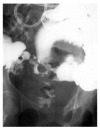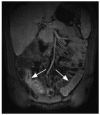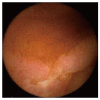Imaging of the small bowel in Crohn's disease: a review of old and new techniques
- PMID: 17659666
- PMCID: PMC4172707
- DOI: 10.3748/wjg.v13.i24.3279
Imaging of the small bowel in Crohn's disease: a review of old and new techniques
Abstract
The investigation of small bowel morphology is often mandatory in many patients with Crohn's disease. Traditional radiological techniques (small bowel enteroclysis and small bowel follow-through) have long been the only suitable methods for this purpose. In recent years, several alternative imaging techniques have been proposed. To review the most recent advances in imaging studies of the small bowel, with particular reference to their possible application in Crohn's disease, we conducted a complete review of the most important studies in which traditional and newer imaging methods were performed and compared in patients with Crohn's disease. Several radiological and endoscopic techniques are now available for the study of the small bowel; each of them is characterized by a distinct profile of favourable and unfavourable features. In some cases, they may also be used as complementary rather than alternative techniques. In everyday practice, the choice of the technique to be used stands upon its availability and a careful evaluation of diagnostic accuracy, clinical usefulness, safety and cost. The recent development of innovative imaging techniques has opened a new and exciting area in the exploration of the small bowel in Crohn's disease patients.
Figures





Similar articles
-
[Evaluation of small bowel involvement in Crohn's disease by small- bowel videocapsule endoscopy: a prospective comparative study with computed-tomography enteroclysis and small bowel radiography].Tunis Med. 2011 May;89(5):445-51. Tunis Med. 2011. PMID: 21557181 Clinical Trial. French.
-
[Diagnostic imaging and endoscopic methods in Crohn's disease of the small intestine].Ugeskr Laeger. 2009 Aug 17;171(34):2383-8. Ugeskr Laeger. 2009. PMID: 19732520 Review. Danish.
-
Distinct management issues with Crohn's disease of the small intestine.Curr Opin Gastroenterol. 2015 Mar;31(2):92-7. doi: 10.1097/MOG.0000000000000149. Curr Opin Gastroenterol. 2015. PMID: 25594888 Review.
-
Cost effectiveness of alternative imaging strategies for the diagnosis of small-bowel Crohn's disease.Clin Gastroenterol Hepatol. 2010 Mar;8(3):261-7, 267.e1-4. doi: 10.1016/j.cgh.2009.10.032. Epub 2009 Nov 5. Clin Gastroenterol Hepatol. 2010. PMID: 19896559
-
Capsule endoscopy is superior to small-bowel follow-through and equivalent to ileocolonoscopy in suspected Crohn's disease.Clin Gastroenterol Hepatol. 2014 Apr;12(4):609-15. doi: 10.1016/j.cgh.2013.09.028. Epub 2013 Sep 27. Clin Gastroenterol Hepatol. 2014. PMID: 24075891
Cited by
-
Monitoring of leucine-rich alpha-2-glycoprotein and assessment by small bowel capsule endoscopy are prognostic for Crohn's disease patients.JGH Open. 2023 Sep 5;7(9):645-651. doi: 10.1002/jgh3.12964. eCollection 2023 Sep. JGH Open. 2023. PMID: 37744712 Free PMC article.
-
A look into the small bowel in Crohn's disease.Clin Endosc. 2012 Sep;45(3):263-8. doi: 10.5946/ce.2012.45.3.263. Epub 2012 Aug 22. Clin Endosc. 2012. PMID: 22977814 Free PMC article.
-
The role of nasoenteric intubation in the MR study of patients with Crohn's disease: our experience and literature review.Radiol Med. 2011 Apr;116(3):389-406. doi: 10.1007/s11547-010-0605-1. Epub 2010 Oct 27. Radiol Med. 2011. PMID: 20981501 Review. English, Italian.
-
Capsule Endoscopy in Inflammatory Bowel Disease: When? To Whom?Diagnostics (Basel). 2021 Nov 30;11(12):2240. doi: 10.3390/diagnostics11122240. Diagnostics (Basel). 2021. PMID: 34943477 Free PMC article. Review.
-
The Diagnostic Role of Magnetic Resonance Enterography as a Complementary Test to Colonoscopy in Active Crohn's Disease.Middle East J Dig Dis. 2016 Apr;8(2):93-101. doi: 10.15171/mejdd.2016.13. Middle East J Dig Dis. 2016. PMID: 27252815 Free PMC article.
References
-
- Ranzi T, Bodini P, Zambelli A, Politi P, Lupinacci G, Campanini MC, Dal Lago AL, Lisciandrano D, Bianchi PA. Epidemiological aspects of inflammatory bowel disease in a north Italian population: a 4-year prospective study. Eur J Gastroenterol Hepatol. 1996;8:657–661. - PubMed
-
- Fraser GM, Findlay JM. The double contrast enema in ulcerative and Crohn's colitis. Clin Radiol. 1976;27:103–112. - PubMed
-
- Laufer I, Hamilton J. The radiological differentiation between ulcerative and granulomatous colitis by double contrast radiology. Am J Gastroenterol. 1976;66:259–269. - PubMed
-
- Kelvin FM, Maglinte DD. Enteroclysis or small bowel follow-through in Crohn' s diseases? Gastroenterology. 1998;114:1349–1351. - PubMed
-
- Bernstein CN, Boult IF, Greenberg HM, van der Putten W, Duffy G, Grahame GR. A prospective randomized comparison between small bowel enteroclysis and small bowel follow-through in Crohn's disease. Gastroenterology. 1997;113:390–398. - PubMed
Publication types
MeSH terms
LinkOut - more resources
Full Text Sources
Medical

